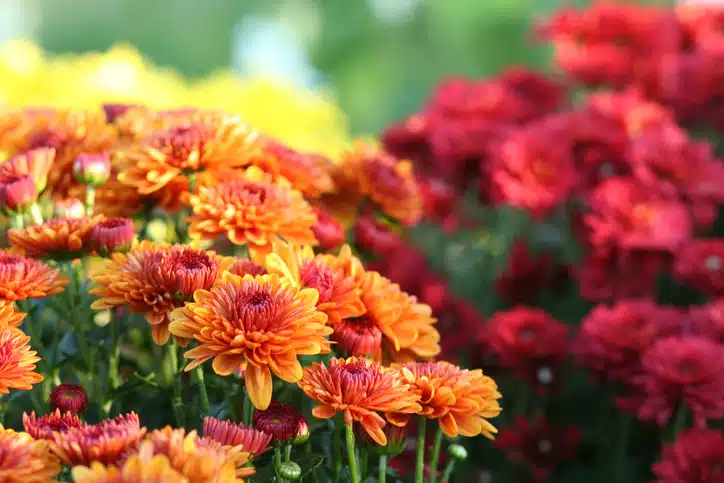As the warmth of summer fades and the crispness of fall approaches, it’s the perfect time to plant for vibrant fall color. September is an excellent month to prepare your garden for stunning hues that will brighten up your landscape throughout the autumn season. At Vertical Landscaping, we specialize in creating beautiful, functional outdoor spaces, and we’re here to share our top tips for planting your garden to showcase fall’s natural beauty.
1. Select Plants That Shine in Fall
When planning for fall color, the first step is choosing plants that naturally provide a burst of color in the autumn months. Some great options for fall foliage and blooms include:
- Trees: Maples, oaks, and sweetgums are known for their stunning fall color. Red maples offer vibrant red leaves, while oaks provide deep red and brown hues. If you’re looking for something a little different, the silver birch tree offers yellow and golden tones that are equally beautiful.
- Shrubs: For consistent color, shrubs like burning bush, sumac, and spirea are great choices. These plants offer rich reds, purples, and oranges that will stand out in any landscape.
- Perennials: Asters, chrysanthemums, and sedums bloom later in the season, providing vibrant fall color. They also attract pollinators like bees and butterflies, which is a nice bonus for your garden.
- Ornamental Grasses: Grasses such as fountain grass and switchgrass can add texture and color to your landscape. Their golden and rust-colored tones beautifully complement other fall foliage.
2. Incorporate Late-Blooming Flowers
While the spring and summer months are known for their blooming flowers, there are plenty of late-blooming plants that shine in September and October. Some of our favorites include:
- Chrysanthemums: These classic fall flowers come in various colors, from deep oranges to soft purples, and can add a warm touch to your garden.
- Asters: Known for their brilliant purple and pink hues, asters bloom well into the fall and are a great choice for extending the color in your garden.
- Goldenrod: This plant provides a beautiful golden yellow that pairs perfectly with the reds and oranges of fall foliage.
3. Evergreens for Year-Round Appeal
Don’t forget about evergreens in your landscape design! While deciduous trees and shrubs provide beautiful fall color, evergreens add structure and interest all year long. Whether you’re looking for a bold focal point or just want to fill in gaps, evergreens like pines, spruces, and hollies are perfect for adding texture and color to your landscape during the cooler months.
4. Utilize Seasonal Containers for Instant Fall Color
For an instant fall makeover, consider adding seasonal containers to your porch, patio, or garden beds. Containers are an easy and affordable way to bring fall color to your outdoor space. Mix plants like ornamental kale, pansies, and mums in large pots to create a seasonal display that’s sure to impress.
5. Water and Maintain Regularly
Although fall brings cooler temperatures, your plants still need regular care, especially after planting. Be sure to water consistently, but avoid overwatering. As the ground cools down, your plants will be working on establishing their roots before winter arrives. Regular watering will help them become more established and make it easier for them to weather the colder months.
6. Mulch for Protection and Moisture Retention
Once you’ve planted your fall garden, consider adding a layer of mulch around your plants. Mulch helps retain moisture, keeps the soil temperature stable, and prevents weeds from taking over. It also protects plant roots as temperatures drop, ensuring they’re well-prepared for the winter.
7. Prune and Deadhead Plants for Better Growth
Pruning is an essential part of maintaining a healthy, vibrant garden. Be sure to remove any dead or damaged branches from your trees and shrubs, as this will encourage new growth. Deadheading your flowers is also important to keep them looking their best. For plants that bloom later in the season, like asters and mums, remove spent blooms to encourage fresh growth.
8. Consider Planting Fall Bulbs for Spring Color
While you’re focused on fall color, don’t forget about planting bulbs for a pop of color when spring rolls around. Bulbs like crocuses, daffodils, and tulips should be planted in the fall to bloom beautifully once the warmer weather arrives. Planting them now ensures your garden will have early-season color to complement the autumn colors.
9. Plan for a Balanced Landscape
When planting for fall color, it’s essential to think about balance and variety. A well-planned landscape includes a mix of evergreens, shrubs, perennials, and trees, ensuring that there’s something of interest year-round. By incorporating a variety of colors and textures, you can create a dynamic landscape that’s both beautiful and functional throughout all seasons.
10. Seek Professional Help for Expert Advice
If you’re unsure where to start or need help planning your fall garden, don’t hesitate to reach out to a professional landscaper. The team at Vertical Landscaping is here to help you design and maintain the perfect outdoor space for any season. With our expertise, we can guide you in selecting the best plants, arranging them for maximum impact, and ensuring your garden thrives year after year.
Get Ready for Fall with Vertical Landscaping
At Vertical Landscaping, we specialize in creating beautiful outdoor spaces that shine year-round. Whether you’re looking to add vibrant fall colors to your garden or need help maintaining your landscape, we’ve got you covered. Visit our website to learn more about our services, or contact us today for a consultation.




